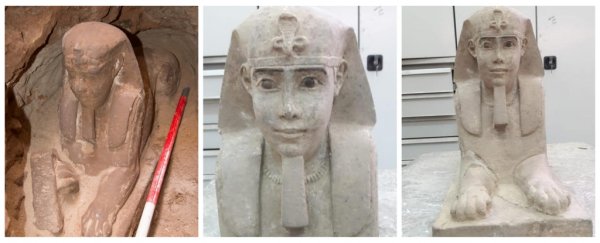Archaeologists excavating the ruins of an ancient Egyptian temple have made the exquisite discovery of a sandstone sphinx statue that's been hidden for thousands of years.
The statue was found in the pharaonic temple of Kom Ombo, near the town of Aswan, as researchers were draining groundwater from the site, Mostafa Waziri of the Egyptian Ministry of Antiquities announced via Facebook.
It is the latest in a string of archaeological discoveries that the Egyptian Ministry of Antiquities has recently announced via the social media site, likely to generate renewed tourist interest in the country.
While it's definitely exciting, this particular sphinx is not the giant kind, though - it stands at just 38 centimetres (15 inches) high.
Two months ago, archaeologists found two sandstone reliefs of King Ptolemy V in the same section of the temple, the southern half dedicated to the crocodile-headed fertility god Sobek (the northern part was dedicated to the falcon-headed Horus).
This ties the sphinx to the Ptolemaic dynasty, between 305 and 30 BCE.
Ptolemy V, whose deeds were recorded on the famous Rosetta Stone, reigned from 204 to 181 BCE; construction on the temple was started after his death by his successor, Ptolemy VI Philometor, and continued by successive Ptolemies.
The purpose and significance of the sphinx is not yet known, but it would have been an important item. In ancient Egypt, sphinxes were associated with the Pharaohs, and were often placed as tomb guardians.
Some of the rulers even had their likenesses carved as the sphinx's head, to symbolise their close relationship with the lioness-headed sun goddess Sekhmet.
Queen Hatshepsut's sphinx is particularly famous; and, of course, there's the Great Sphinx of Giza, thought to represent King Khafre.
This newly discovered sphinx is remarkably unweathered, showing a lifelike face with a piercing gaze.
Archaeologists will be studying it to see if they can figure out what it was for (and hopefully if it is the portrait of one of the Ptolemies) before it is taken to the National Museum of Egyptian Civilisation in Fustat for conservation and exhibition.
